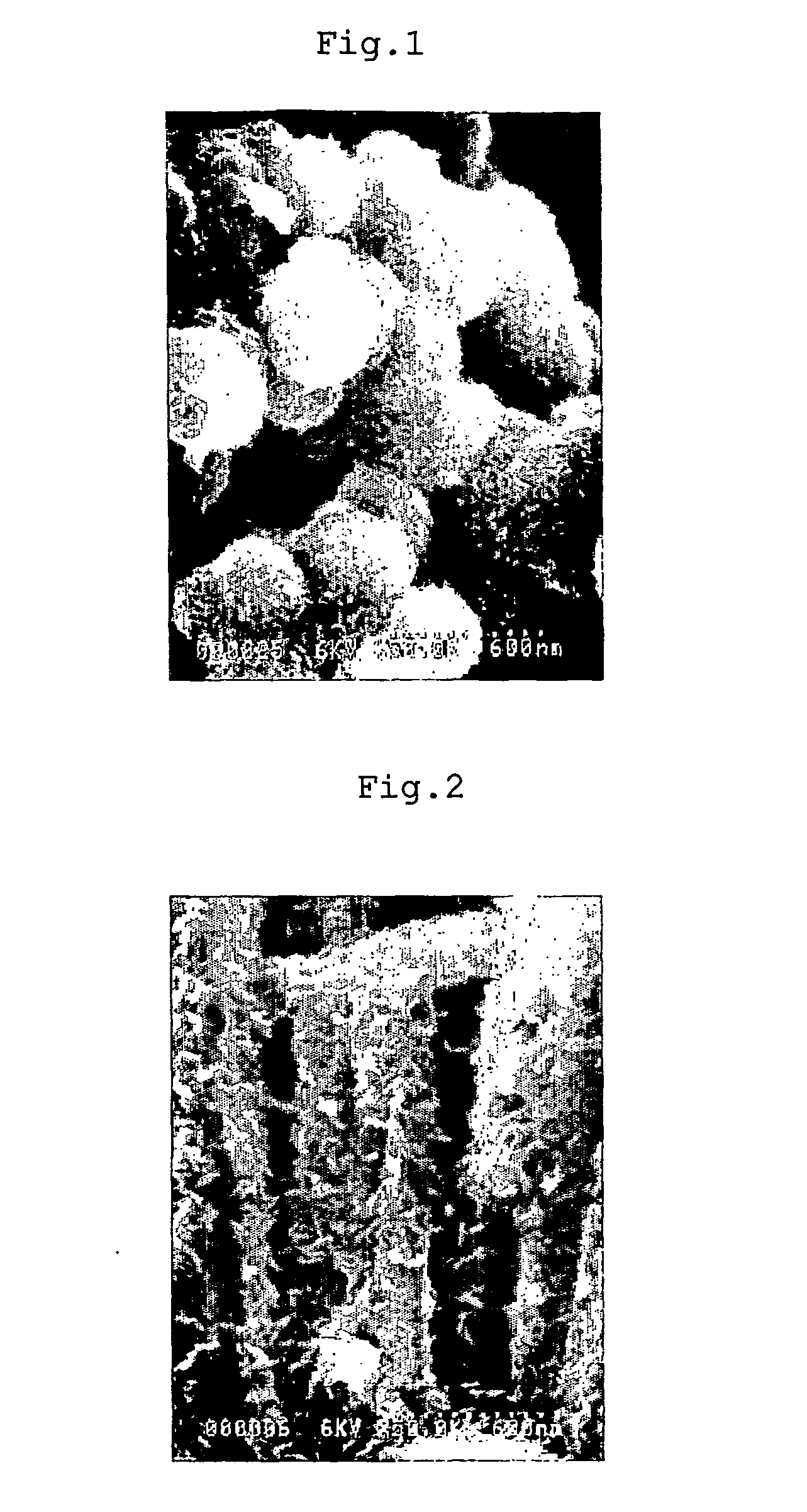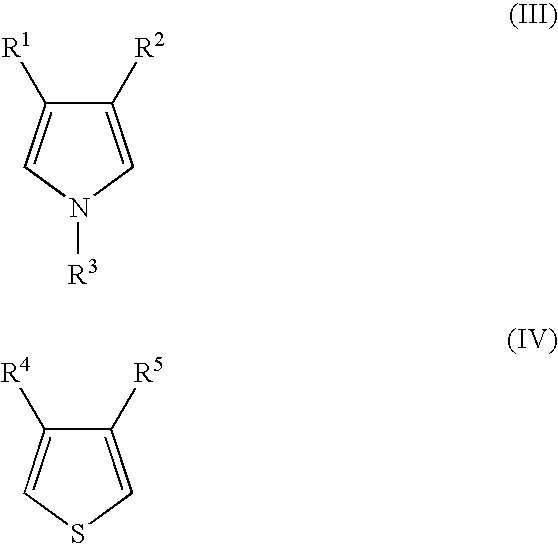Conjugated copolymer, production method thereof and capacitor using the copolymer
a copolymer and production method technology, applied in the direction of electrolytic capacitors, capacitor details, cell components, etc., can solve the problems of inability to manufacture in mass quantities, general insoluble electrically conductive polymers, so as to achieve the effect of increasing the electrical conductivity of the -conjugated copolymer
- Summary
- Abstract
- Description
- Claims
- Application Information
AI Technical Summary
Benefits of technology
Problems solved by technology
Method used
Image
Examples
example 1
3,4-Ethylenedioxythiophene:Pyrrole=9:1
[0089] 1.70 g of ammonium persulfate was weighed and charged into a 30 ml three-neck round bottom flask, 5.0 ml of water was added thereto, and the resulting solution was cooled to 0° C. while stirring in an ice bath. A sample tube was prepared, 0. 03 g of pyrrole and 0.48 g of 3,4-ethylenedioxythiophene were weighed and charged into the tube, 1.3 ml of isopropyl alcohol was added thereto and stirred to prepare a monomer solution. The monomer solution was added dropwise to the aqueous ammonium persulfate solution cooled at 0° C., and stirred for 2 hours.
[0090] After the 2 hours of stirring, 100 ml of water was added to the reaction solution and stirred for 1 hour, and the solution was filtrated to remove the water-soluble impurities. Then, 100 ml of acetone was added to the obtained black solid and stirred for 1 hour, to remove the soluble components.
[0091] The resultant was dried at 50° C. for 3 hours under reduced pressure, then the mass wa...
example 2
3,4-Ethylenedioxythiophene:Pyrrole=7:3
[0092] 1.91 g of ammonium persulfate was weighed and charged into a 30 ml three-neck round bottom flask, 5.6 ml of water was added thereto, and the resulting solution was cooled to 0° C. while stirring in an ice bath. A sample tube was prepared, 0.09 g of pyrrole and 0.42 g of 3,4-ethylenedioxythiophene were weighed and charged into the tube, 1.4 ml of isopropyl alcohol was added thereto and stirred to prepare a monomer solution. The monomer solution was added dropwise to the aqueous ammonium persulfate solution cooled at 0° C., and stirred for 2 hours.
[0093] After the 2 hours of stirring, 100 ml of water was added to the reaction solution and stirred for 1 hour, and the solution was filtrated to remove the water-soluble impurities. Then, 100 ml of acetone was added to the obtained black solid and stirred for 1 hour, to remove the soluble components.
[0094] The resultant was dried at 50° C. for 3 hours under reduced pressure and then the mass ...
example 3
3,4-Ethylenedioxythiophene:Pyrrole=5:5
[0096] 2.18 g of ammonium persulfate was weighed and charged into a 30 ml three-neck round bottom flask, 6.4 ml of water was added thereto, and the resulting solution was cooled to 0° C. while stirring in an ice bath. A sample tube was prepared, 0.16 g of pyrrole and 0.34 g of 3,4-ethylenedioxythiophene were weighed and charged into the tube, 1.6 ml of isopropyl alcohol was added thereto and stirred to prepare a monomer solution. The monomer solution was added dropwise to the aqueous ammonium persulfate solution cooled at 0° C., and stirred for 2 hours.
[0097] After the 2 hours of stirring, 100 ml of water was added to the reaction solution and stirred for 1 hour, and the solution was filtrated to remove the water-soluble impurities. Then, 100 ml of acetone was added to the obtained black solid and stirred for 1 hour, to remove the soluble components.
[0098] The resultant was dried at 50° C. for 3 hours under reduced pressure and then the mass ...
PUM
| Property | Measurement | Unit |
|---|---|---|
| Temperature | aaaaa | aaaaa |
| Temperature | aaaaa | aaaaa |
| Temperature | aaaaa | aaaaa |
Abstract
Description
Claims
Application Information
 Login to View More
Login to View More - R&D
- Intellectual Property
- Life Sciences
- Materials
- Tech Scout
- Unparalleled Data Quality
- Higher Quality Content
- 60% Fewer Hallucinations
Browse by: Latest US Patents, China's latest patents, Technical Efficacy Thesaurus, Application Domain, Technology Topic, Popular Technical Reports.
© 2025 PatSnap. All rights reserved.Legal|Privacy policy|Modern Slavery Act Transparency Statement|Sitemap|About US| Contact US: help@patsnap.com



